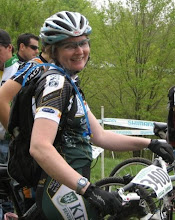I've heard a lot of our instructors talking about "feeling the side of the foot" when turning the legs. When I ask if they can feel the side of their big toe during bow-ties or figure 8's in boots, they say they do. Here's a secret: I don't. And no, it's not because I have boots three sizes too big. So can we really expect our beginner skiers to feel a such subtle difference - resistance from the side of the boot versus pressure down onto the foot?
That downward pressure isn't desired at the beginner level - it means our skiers are either tipping the skis on edge without control over turn radius or (more likely) are pressuring the outside ski to turn, a strategy that will not promote progression to parallel.
Part of learning any sport is becoming familiar with and paying attention to the sensations. In another post, I'll discuss how you can tune into sensations to improve your skiing. For now, lets think about it from the beginner skier's perspective.
So how can we describe movements accurately to beginners? Refer to large body parts rather than small ones. Keep it simple yet specific. What should move? Where? What is the resulting sensation?
Here are some phrases I use. (and yes, I still teach beginner skiers. Frequently. It's fun.) Note that when working with more advanced skiers, I modify these to describe some of the nuances of the movements. Chime in with your own or any questions in the comments.
Fore-aft and lateral balancing movements:
Smoosh the front of the boot
Keep your shin touching the boot
Lean on the boots
Bring your hips forward
Bend your ankles
Stand taller
Tuck your bum in
Feel about the same amount of weight on each foot
Leg steering movements:
Point your skis toward me
Turn both knees in the direction you want to go
Turn your legs more than your body
Turn your legs
Your feet point where the skis will go
Let your legs do the turning work
Hold your hips still, turn the leg
Feel the muscles in your hips working
Use your knees like headlights
Calm your shoulders down
Walk the skis just like we walk down a busy sidewalk
Importantly - when we're developing movements during the footwork phase of a beginner lesson, introduce this language and stick with it! If you really want to ace how to coach people, get them to do it and then ask them what they feel. Then use their language. (A hint, that's where I've gotten many of these ideas!).

ok, but are adv beginners considered beginners. I have a group of newbie Jr Developers who power wedge anything steep (i.e. lower level blue trails). When we go to less steep hills to work on wedge christies with the goal of eliminating the wedge, they have to steer the uphill ski in order to match it to the parallel position with the downhill ski. There has to be more 'pressure' on the downhill ski at this point or they all get stuck in a sliding wedge. So how would you explain 'lightening up' the uphill ski to steer it.
ReplyDeleteI do not use 'weight the downhill ski' or bums end up over the downhill ski, I am reluctant to say pressure but it is 'pressuring' in a sense.
- JetMan
JetMan - you are absolutely correct to take them to easier terrain (and at higher speeds) to encourage speed control through turn shape and develop matching of the skis after the fall line. With regard to the mechanics of the turn, there are two ways for extra weight to get on the outside (downhill) ski. When most people press or put weight on that outside ski, the hips and center of mass move toward the outside of the turn. The result is the inside ski becomes more edged and therefore MORE difficult to steer.
ReplyDeleteBy contrast, if you encourage flexion and extension movements (e.g., bicycle turns, tuck turns, long-leg/short-leg drills, even to shuffle turns or stepping turns), it will promote movement of the center of mass toward the inside of the turn. While the outside ski will bear more weight, the result is quite different - the inside ski flattens and can be easily steered.
Another important point here is to encourage skiers to steer the skis in the first place - often power wedges just press that outside ski to turn. How can you tell? Their hips move toward the outside of the turn and they have trouble when you ask them to change the radius of the turn.
Hope this helps!
-Becky
Well hello there! Have you ever tried to utilize some professional tricks to increase popularity this website? Waiting forward to hear your answer.
ReplyDelete